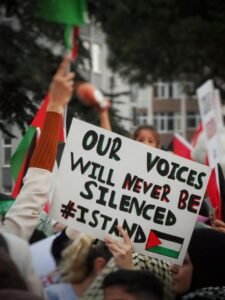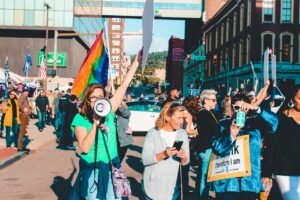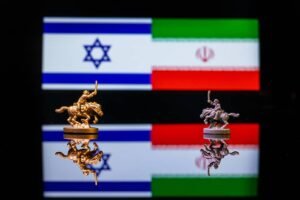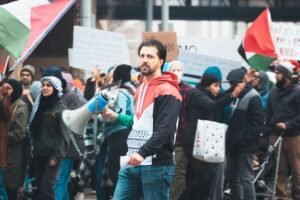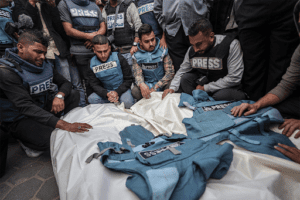“It is only a matter of time until we are killed. We wait our turn, one after the other”
(Salman Al-Bashir, Correspondent, Nov.3, 2023)

Source: The new humanitarian
Being a journalist in Gaza means reporting on the war while residing in a catastrophic situation. It is both difficult and perilous because of the continuous conflict and political tensions all around. Journalists frequently encounter constraints on their coverage, censorship, and threats from various involved parties. They are more vulnerable to physical harm or targeted attacks while reporting on the ground. Despite these obstacles, many Gaza journalists are determined to deliver precise and prompt information to the public, often jeopardizing their own safety. Operating in such a volatile environment demands bravery, perseverance, and a firm dedication to journalistic principles.
Journalist casualties in the Israel-Gaza war are the highest since 1992

Since the start of the Israel-Gaza war on October 7, 2023, journalists and media workers in the region have encountered a hostile environment, which makes reporting on the war extremely difficult. CPJ’s research has uncovered numerous instances of journalists being targeted while performing their work in Palestine, including murder, arrests, assaults, threats, cyberattacks, and censorship.
According to the annual report of the Palestinian Center for Development & Media Freedoms (MADA) in 2023, a minimum of 103 journalists and media workers have been killed since the beginning of the war. The majority of them were killed directly because of their work. This indicates that the number of violations and attacks documented in 2023 has increased by 118% compared to 2022.

According to CPJ data, Israel made a significant increase in ranking on the 2023 list, being responsible for more than 75% of journalist fatalities and moving up to the sixth-highest jailer of journalists following the commencement of the Israel-Gaza conflict on October 7.
While the number of killings significantly decreased from 69 to 22 in 2022, excluding the deaths in the Israel-Gaza conflict, this reduction does not indicate an overall improvement in journalist safety worldwide. According to the CPJ’s annual prison census, journalist imprisonments in 2023 are expected to be on par with the record highs seen in 2022.

More than 65% of journalists in prison in the census are accused of anti-state activities, such as spreading fake news and terrorism, as a form of retaliation for their work. Many census participants are detained without being notified of the charges against them, and they often endure severe and perilous prison conditions.
What is it like being a journalist in Gaza?
“Journalists in Gaza are facing exponential risk”
( Sherif Mansour, CPJ’s Middle East and North Africa program coordinator, April 8, 2024)
To work as a journalist in Gaza means being both the individual who covers an attack and the individual who experiences it. You are the reporter who documents the plight of hundreds of thousands of people who have been forcibly displaced, and you are also one of those who have been forced to flee due to your neighbourhood being bombed and your home being destroyed. You are the one who reports on the electricity shortages in Gaza using pen and paper to save the phone’s battery & share it with the world once you have an internet connection.

Said Khatib/AFP via Getty Images
Journalists in Gaza cannot cover the conflict from a safe distance and retreat when necessary. They reside in the Strip with their loved ones and are surrounded by what the Financial Times has labelled as “a destructive bombing campaign.” More than 50 offices in Gaza were damaged, leaving numerous journalists without a secure workspace amidst widespread power and communications outages, shortages of food and water, and the necessity to evacuate with their families.
Journalists reporting on the conflict in Gaza have highlighted a shortage of personal protective equipment (PPE). The CPJ has received multiple appeals from freelance journalists for PPE. Nevertheless, supplying this gear to journalists in the area poses challenges.
Following multiple incidents of journalists being targeted, Palestinian journalists felt that wearing press vests exposed them to danger. On November 2, Palestine TV reporter Salman al-Bashir took off his flak jacket and helmet while reporting live outside Nasser Hospital in southern Gaza. Al-Bashir was covering the death of his colleague Mohammed Abu Hatab, who, along with 11 members of his family, was killed in an attack on their Khan Younis residence. He said “These safety vests and helmets do not shield us. “Nothing shields journalists.”
The IDF is not only targeting journalists but also their families.
According to the Reuters Institute, Youmna Elsayed, who works as an Al Jazeera English correspondent, her husband received a call from the IDF saying, “You’re speaking to the IDF. You should take your family and leave your home right now. Otherwise, your life will be in danger.” She interpreted this as a threat rather than a warning because none of her neighbours received a similar message. Therefore, she believed that her family was being targeted because of her work as a journalist.
“I wish that the blood of my son will be the last of those journalists killed and those killed in this massacre”
(Wael Al-Dahdouh, Al-Jazeera Gaza bureau chief, Jan. 7, 2024 )
Journalists in Gaza encounter significant challenges both mentally and physically in their profession. Constant exposure to violence, conflict, and trauma impacts mental health, resulting in high levels of stress, anxiety, and even post-traumatic stress disorder. The fear of being targeted or injured while reporting on the ground further adds to their psychological burden.
Physically, journalists in Gaza face risks due to the perilous nature of their work. They frequently find themselves amidst violent clashes, bombings, and other hazardous situations that jeopardize their safety. Additionally, they may encounter movement restrictions, harassment, or direct attacks from various parties involved in the conflict.
Despite these obstacles, journalists in Gaza persist in their efforts to report on the ground, often jeopardizing their well-being to shed light on the ongoing humanitarian crisis in the region. Their dedication and courage in the face of adversity are commendable, but their mental and physical well-being must be prioritized and supported.

Source: Egyptian Street
On Oct. 25, Wael Dahdouh, an Al Jazeera correspondent, received the devastating news while on air that the majority of his family had been killed in an airstrike on the home where they were seeking shelter. Dahdouh bravely resumed work just one day after the tragic loss of most of his family members, expressing that, as Al Jazeera’s bureau chief in Gaza, he believed it was his duty to promptly return to work.
Female Journalists face significant risks in conflict zones
Since October 7, 2023, a minimum of 18 female journalists have been murdered and 4 have been wounded, as reported by Women Press Freedom.

Source: Women press freedom
Female journalists in Gaza are facing significant risks in conflict zones. The challenging and dangerous conditions in conflict areas make it especially difficult for women to report on events and stories. Despite these risks, female journalists in Gaza continue to bravely cover important news and provide valuable insights into the ongoing conflicts in the region.
One of the main challenges faced by female journalists in Gaza is the threat of physical harm. In conflict zones, journalists are often targeted by various parties involved in the fighting, and women are particularly vulnerable to violence and harassment. Female journalists have reported being subjected to intimidation, harassment, and even assault while trying to do their jobs.
On Oct.16, reporter Dalia Al-Nimri from Russia Today was threatened at gunpoint by Israeli border guards in Al-Quds, West Bank. The officers instructed the journalist to cease reporting and mentioned that they were compiling a file on Al-Nimri for Shin Bet, the Israeli intelligence agency.

Source: Women’s press freedom
Despite these challenges, female journalists in Gaza continue to play a crucial role in bringing attention to the conflicts and human rights abuses happening in the region. Their reporting sheds light on important issues and helps to hold those responsible for violence and injustice accountable.
“ As a Palestinian living in Gaza, you don’t have a choice but to be a war journalist”
( Plestia Alaqad, Citizen journalist, Jan. 19, 2024)
On Oct. 7, Israel restricted civilian entry to Gaza following Hamas’s aggressive assault on southern Israel, resulting in the region being engulfed in conflict. Since then, only journalists who were already present in the enclave, mainly local freelancers or those accompanied by the military under strict supervision, have been able to cover events from inside Gaza. Human Rights Watch cautioned that the blackout could be used as a shield against atrocities and human rights abuses. The Committee to Protect Journalists cautioned that it could lead to “serious consequences” and the spread of misinformation.
In a climate of media censorship and misinformation, Palestinians have no option but to become “citizen journalists“. Citizen journalism is based on the fundamental idea that information provided to the public is not dependent on official sources or organizations. Instead, it is created independently and shared through a non-linear process. This approach allows for a wider variety of perspectives and options compared to traditional news outlets and other media platforms. Most of these citizen journalists and reporters are aged between 17 and 25. They utilize their social media platforms to share their most intimate moments of loss and struggle with millions of audiences.
“I take pictures and record some videos on my phone; I post it and don’t look back. It’s not something human”
( Motaz Aziza, photojournalist, Jan.23, 2024).
“Man of the Year” as named by GQ Middle East, Aziza saw his Instagram following surge from a reported 25,000 before the violence began to over 18.3 million — surpassing even the number of followers in the U.S. President Joe Biden’s official account on the platform.

Source: Instagram profiles
Palestinian citizen journalists and reporters are like a family to their audiences. When they are not sharing updates on social media, their comments are flooded with concerned people from around the world. Unfortunately, some of them have been forced to leave Gaza because of IDF violations against journalists and their families, leading to growing fears for their families.
How does the IDF handle journalists & media outlets during the war?
According to the Freedom Committee of the Palestinian Journalists Syndicate monthly report, the Israeli occupation committed at least 135 crimes, assaults, and violations against journalism in Palestine in January. The most severe of these was the killing of 14 journalists, with 8 being killed by direct missile and bullet attacks on their homes, and 4 others killed while on duty.
Hamza Al Dahdouh, 27, a Palestinian journalist and cameraman for Qatar-based channel Al-Jazeera, was killed in an Israeli drone attack on January 7, 2024, along with Mustafa Thuraya, a freelance video journalist who worked for Agence France-Presse (AFP), as reported by media outlets. The attack targeted their vehicle as they were returning from an assignment for Al-Jazeera in Nasr village, also known as Moraj, northeast of Rafah in southern Gaza.

Source: AFP – Getty Images
The Israel Forces Spokesperson’s Unit stated that Al Dahdouh and Thuraya were in the car with “a terrorist who operated an aircraft in a way that put IDF forces at risk,” according to the Times of Israel. The IDF also stated that it was aware of “the claim that during the strike, two other suspects who were with the terrorist in the same vehicle were hit.”
In addition, Israeli forces detained Palestinian journalists at Al-Shifa Hospital in northern Gaza, blindfolded them, and forced them to strip down to their underwear, as reported by eyewitnesses on CNN.
“We were blindfolded and bound as we waited to be freed, We were uncertain of our whereabouts and destination”
(Samer Tarazi, correspondent, March 21, 2024)
After being detained, the IDF directed Tarazi and his companions to move south along Al Rashid Street. “We were released without our IDs or cell phones,” he added. Al Jazeera stated that Tarazi and his coworkers were arrested and subjected to severe beatings before being taken to an undisclosed location for questioning. The IDF responded that “ they had no record of detaining Tarazi or his colleagues”.
The IDF violations against journalists not only occurred on the ground but also indirectly targeted citizen journalists and reporters. The IDF understood the influence of citizen journalists & reporters on social media, leading them to directly target telecommunication towers in Gaza to blackout them from the world. This direct targeting resulted in a complete interruption of communication and internet services for 14 days in January. According to a report by WAFA, several technical staff were killed by the Israeli occupation while trying to repair the damage.
In addition, they attempted to hack the accounts of the most influential Palestinian journalists on social media. For instance, Plestia Alaqad’s Instagram account, a crucial tool in her reporting, was compromised, resulting in misleading posts that caused confusion and worry among her followers.
“Al Jazeera will no longer be broadcast from Israel”
(Netanyahu, prime minister of Israel, April 1, 2024).
Moreover, the Israeli government is issuing orders and new laws to close down media outlets in Gaza. On Monday, April 1, the Israeli parliament passed a bill allowing it to shut down Al Jazeera’s news operations in Israel temporarily for 45 days which could be renewed, a decision the White House labelled as a “concerning” restriction of press freedom. The bill, approved by a 71-10 vote, sets the stage for Israel to close down foreign news outlets it considers a security risk—a move widely seen as targeting Al Jazeera. Israel has criticized the Qatar-based outlet as a propaganda tool for Hamas in Gaza, and Prime Minister Benjamin Netanyahu accused the organization on Monday of assisting Hamas terrorists during the Oct. 7 attack. The broadcaster criticized Netanyahu’s incitement accusation as a “dangerous and absurd lie.” It emphasized holding Netanyahu responsible for the safety of its staff and offices, committing to maintain its “bold and professional coverage,” and asserting its right to take legal action if necessary.
Israel has had a tense relationship with Al Jazeera, alleging the network’s bias against Israel. About two years ago, Al Jazeera reporter Shireen Abu Akleh was killed during an Israeli military mission in the occupied West Bank, leading to a notable deterioration in relations.
Also, the IDF, on Oct. 16, issued an order to close the West Bank-based J-Media agency, as reported by the Palestinian press freedom organization MADA. The IDF described J-Media as an “Illegal organization” and justified the closure as necessary for “the security of the State of Israel and the well-being of the public and public order.”
Global violations against journalists and media workers
Journalists worldwide facing violations due to their “Solidarity with Palestine” is not a new phenomenon. In 2021, journalist Emily Wilder was fired from her position at the Associated Press after only two weeks, following a campaign by conservative media that emphasized her previous social media posts supporting Palestinian liberation.
In a comparable case last October, the BBC conducted an investigation into four journalists from its Cairo desk and two from its Beirut desk for endorsing and sharing pro-Palestine social media posts. The inquiry was initiated following a similar defamation report in The Telegraph.
On April 5, Egyptian authorities arrested around 14 demonstrators within 24 hours of their involvement in a pro-Gaza protest outside the Journalists’ Syndicate headquarters in downtown Cairo. They were released after two days of being detained.
In addition to that, the Guardian newspaper announced it would not renew the contract of Steve Bell, one of its longest-serving cartoonists after he criticized the publication for not publishing a cartoon showing Netanyahu tearing a piece of his stomach with a scalpel in the shape of Gaza.

Source:lastampa.it
Others have faced different forms of discipline. Samira Nasr from Harper’s Bazaar had to issue an apology for publicly condemning Israel’s blockade of electricity and water in Gaza as “inhuman”; the leftist podcast “By Any Means Necessary” was removed from the airwaves after its hosts advocated for the “legitimate struggle of the Palestinian people against apartheid and colonialism”.
Unfortunately, up to this point, journalists worldwide have been violated and censored for criticizing Israel’s military operation and exposing its deadly consequences for Palestinians.
Actions to Ensure Journalist Safety and Address the Issue of Impunity
Journalists and other media professionals face a significant risk of being arbitrarily detained for alleged security reasons. It is crucial to distinguish between “war correspondents” (Article 4A (4) of the Third Geneva Convention) and “journalists” (Article 79 of Additional Protocol I). Both are considered civilians, but only war correspondents are entitled to prisoner of war status. War correspondents are officially permitted to accompany the armed forces. Due to this close association, if they are captured, they are afforded the same legal status as military personnel. As a result, war correspondents enjoy the protections of the Third Geneva Convention, which are further reinforced by Additional Protocol I and customary international law.
Journalists are protected by international humanitarian law from direct attacks as they are civilians, unless and until they engage in hostilities. Violating this rule is a serious breach of the Geneva Conventions and Additional Protocol I. Nevertheless, both professional and citizen journalists reporting on the conflict in Palestine are not afforded legal protection; instead, they are perceived as a danger and become targets.
One of the most important challenges confronting journalists today is impunity, which allows perpetrators of crimes against journalists to go unpunished. To secure journalist safety and address the issue of impunity, real steps must be made at both the national and international levels. First and foremost, governments must accept responsibility for protecting and ensuring journalists’ safety. This entails establishing and enforcing legislation to preserve press freedom, ensuring journalists’ right to report without fear of retaliation, and holding those who commit crimes against journalists accountable. Governments must also give journalists the necessary resources and support to carry out their work safely, including access to training, legal aid, and physical protection as needed.
At the international level, it is critical that the issue of journalist safety and impunity be addressed through multilateral cooperation. International organizations such as the United Nations and the International Federation of Journalists play an important role in advocating for journalist safety and press freedom, as well as monitoring and documenting incidents of journalist violence. In addition to government and international efforts, civil society plays a critical role in protecting journalist safety and combating impunity. Media outlets, advocacy groups, and non-governmental organizations can offer journalists assistance, resources, and solidarity in the face of threats and attacks. Civil society can contribute to public support for journalist safety and accountability by raising awareness about the importance of press freedom and the threats that journalists face.
Finally, ensuring journalist safety and addressing impunity are significant issues that require a coordinated and comprehensive approach. Through targeted measures at both national and international levels, international organizations, civil society, and governments can collaborate to protect journalists, uphold press freedom, and hold those responsible for crimes against journalists to account.
Times For Palestine
Open Source report
Sources:
https://www.womeninjournalism.org/infocus-all/gaza-reporting-under-fire


